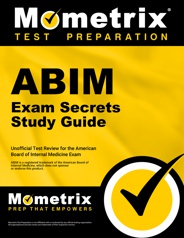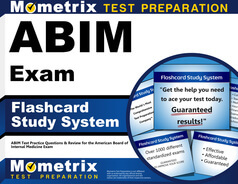The American Board of Internal Medicine (ABIM) has developed the Internal Medicine certification exam to assess the knowledge, clinical skills, and diagnostic reasoning of prospective internists.
Click “Start Test” above to take a free ABIM certification practice test, and check out our premium-quality ABIM test prep resources by clicking the links below!
Exam Eligibility
To be eligible for the ABIM Internal Medicine certification exam, you must meet the following requirements:
- You must have at least 36 months of accredited internal medicine training
- You must have at least 30 months of clinical experience/education
ABIM Internal Medicine Exam Outline
The ABIM Internal Medicine exam contains 240 multiple-choice questions, 35 of which are unscored, and you will be given a time limit of 8 hours to complete the exam.
The exam is split into 18 medical content categories.
- Allergy and immunology (2%)
- Cardiovascular disease (14%)
- Dermatology (3%)
- Endocrinology, diabetes, and metabolism (9%)
- Gastroenterology (9%)
- Hematology (6%)
- Infectious disease (9%)
- Miscellaneous (2%)
- Nephrology and urology (6%)
- Neurology (4%)
- Obstetrics and gynecology (3%)
- Medical oncology (6%)
- Ophthalmology (1%)
- Otolaryngology and dental medicine (1%)
- Psychiatry (4%)
- Pulmonary disease (9%)
- Rheumatology and orthopedics (9%)
- Geriatric syndromes (3%)
Check Out Mometrix's ABIM Study Guide
Get practice questions, video tutorials, and detailed study lessons
Get Your Study Guide
Registration
To register for the exam, you must submit an application to ABIM, along with the $1,430 examination fee. Once your application has been approved, you will receive an Authorization to Test (ATT) and information on how to schedule your exam appointment.
Test Day
You should arrive at the Pearson VUE testing center at least 30 minutes before the scheduled exam to allow time for the check-in procedures. During check-in, you will be asked for two valid forms of ID, and at least one form of ID must contain a photo. Failure to provide this identification will result in your exam being cancelled.
Before you enter the testing room, you will be asked to leave all personal items behind, including your phone, wallet, bags, and keys.
Once the exam begins, you will be given specific break periods to use at your leisure.
How the Exam is Scored
Your ABIM exam score is reported on a scale from 200 to 800, with 366 being the minimum passing score requirement. A scaled score is calculated based on the number of correctly answered questions, also known as a “raw score.”
You should receive your official score report within three months of your testing appointment.
Check Out Mometrix's ABIM Flashcards
Get complex subjects broken down into easily understandable concepts
Get Your Flashcards
FAQs
Q
How many questions are on the ABIM Internal Medicine exam?
A
There are 240 multiple-choice questions on the exam.
Q
How long is the ABIM Internal Medicine exam?
A
The maximum time limit for this exam is 8 hours.
Q
What is the passing score for the ABIM Internal Medicine exam?
A
To pass the exam, you must achieve a minimum scaled score of 366.
Q
How much does the ABIM Internal Medicine exam cost?
A
The examination fee is $1,430.
Mometrix Test Preparation is not affiliated with or endorsed by any official testing organization. All organizational and test names are trademarks of their respective owners.
